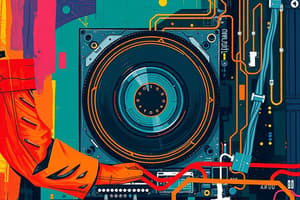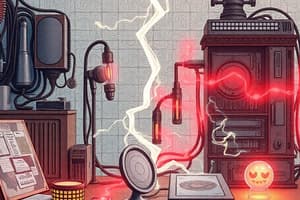Podcast
Questions and Answers
What is the primary responsibility of the 'brains' of the computer?
What is the primary responsibility of the 'brains' of the computer?
- To cool down the system
- To execute instructions (correct)
- To store data
- To provide power to the computer
What is the main difference between a modem and a router?
What is the main difference between a modem and a router?
- A modem is used for wireless connections, while a router is used for wired connections
- A modem is used for email, while a router is used for social media
- A modem is used for online gaming, while a router is used for online browsing
- A modem connects to the internet, while a router connects to devices (correct)
What is a key characteristic of good literacy skills?
What is a key characteristic of good literacy skills?
- Only reading news from one source
- Trusting friends who post on social media
- Verifying information with reputable sources (correct)
- Quickly sharing stories on social media
What is the primary purpose of Google Keep?
What is the primary purpose of Google Keep?
What is the polyline tool used for in Google Drawings?
What is the polyline tool used for in Google Drawings?
Why is it important to create the background before creating a Stop Motion?
Why is it important to create the background before creating a Stop Motion?
What is the primary function of a Compiler?
What is the primary function of a Compiler?
What is the purpose of a Circuit?
What is the purpose of a Circuit?
In Google Docs, how do you place text beside an image?
In Google Docs, how do you place text beside an image?
What is the function of Read-only memory (ROM)?
What is the function of Read-only memory (ROM)?
What is the purpose of Data Validation in Google Sheets?
What is the purpose of Data Validation in Google Sheets?
What is the primary purpose of an Algorithm?
What is the primary purpose of an Algorithm?
Flashcards
What is the CPU?
What is the CPU?
The 'brain' of the computer, responsible for processing information.
What is a modem?
What is a modem?
A device that connects a computer to the internet.
What is a bit?
What is a bit?
Data is stored in a computer using units called bytes. A byte is composed of 8 of these.
What is an algorithm?
What is an algorithm?
Signup and view all the flashcards
What is custom software?
What is custom software?
Signup and view all the flashcards
What is ROM?
What is ROM?
Signup and view all the flashcards
What is an inkjet printer?
What is an inkjet printer?
Signup and view all the flashcards
What is Stop Motion animation?
What is Stop Motion animation?
Signup and view all the flashcards
What is a script editor?
What is a script editor?
Signup and view all the flashcards
What is deployment?
What is deployment?
Signup and view all the flashcards
What is a bit?
What is a bit?
Signup and view all the flashcards
What is sorting?
What is sorting?
Signup and view all the flashcards
Study Notes
Hardware Components
- The "brain" of the computer is the CPU (Central Processing Unit), which is located on the motherboard.
- The CPU is held in a socket or case on the motherboard.
Online Safety
- When online, never share your password with anyone except your parents.
- Sharing your password with others can compromise your online safety.
Computer Terminology
- A personal computer is also known as a PC.
- Sound is input through a device such as a microphone or speakers.
Networking Devices
- A modem connects to the internet, while a router connects devices to the network.
- There are two types of printers: inkjet and laser, with inkjet being the most common type found at home.
Data Representation
- A byte is composed of 8 bits.
Digital Citizenship
- The 3 rings of responsibility are: myself, my community, and my world.
Information Literacy
- Good literacy skills involve slowing down to verify information with reputable sources before sharing.
- Bad literacy skills involve quickly sharing stories without verifying their accuracy.
Google Keep
- Google Keep is a note-taking app that allows users to jot down quick notes and reminders.
- Google Keep can be accessed through the Google Drive menu, the Google Keep website, or the mobile app.
- Features of Google Keep include:
- Color-coding notes
- Adding reminders
- Creating to-do lists
- Sharing notes with others
- Adding photos and audio to notes
Google Drawings
- Google Drawings can be accessed through the Google Drive menu or the Google Drawings website.
- The polyline tool is used to create custom shapes and lines.
- Google Drawings is useful for creating diagrams, flowcharts, and other visual aids.
- The polyline tool is used to create custom shapes and lines.
Stop Motion
- Stop Motion is a technique used to create animated videos by taking multiple photos and playing them in sequence.
- Creating a background before creating Stop Motion is important because it provides a consistent setting for the animation.
- Using multiple duplicate slides for Stop Motion when working with text or words is important because it allows for smooth animation.
- To duplicate a slide, use the keyboard shortcut Ctrl+D (Windows) or Command+D (Mac).
- To put a Stop Motion project on a loop, click on the "Publish" button and select "Loop" from the options.
Google Docs
- When creating a Table of Contents, it's most important to link pages correctly.
- To put text to the side of an image, use the "Wrap text" feature.
- It's important to drag from the corner "handle" when resizing an image to maintain its aspect ratio.
Google Sites
- The "Preview" icon should be used often to ensure the site is displaying correctly.
- It's important to include the source of images used from the internet to avoid copyright infringement.
- To create a new page, click on the "New page" button.
- The "Content Blocks/Templates" are located in the "Insert" menu.
Computer Science Definitions
- Compiler: a language that translates source code into binary form.
- Supercomputer: a high-speed computer for complex work.
- Input devices: devices that allow users to input text, images, and sound.
- If-statements: define conditions that must be met for the program to move to the next step.
- Read-only memory (ROM): a set of chips that starts the computer when it is turned on.
- Algorithm: a sequence of instructions.
- Circuit: a network of connected electronic components.
- Motherboard: where the CPU (central processing unit) is located.
- Server: a computer accessed by users on a network.
- Repetitive Strain Injury (RSI): a condition caused by making the same movements again and again.
- Scanner: lets you input printed images into a computer.
- Bit: the basic unit of data a digital computer can understand.
- LCD or CRT: CRTs are heavy, take up space, use more electricity, and heat up easily, whereas LCDs are more modern and efficient.
- Custom Software: software programs designed to do a very specific job.
Google Sheets Definitions
- Data Validation: restricts the input data in a cell to a specific format.
- Sorting: arranging data in a specific order.
- Spreadsheet: a table of data with rows and columns.
- Cell: a single unit of data in a spreadsheet.
- Freeze: locking specific rows or columns in place.
- Filter/Filter View: narrowing down data to specific criteria.
- Functions: pre-built formulas that perform calculations.
- Average: a calculation that finds the mean value.
- Conditional Formatting: formatting cells based on specific conditions.
- Charts: visual representations of data.
- Links: connections between cells or sheets.
Coding Definitions
- Code: a set of instructions written in a programming language.
- Script editor: a tool used to write and edit code.
- Deployment: the process of releasing code to users.
- String: a sequence of characters.
- Debugging: the process of finding and fixing errors in code.
Studying That Suits You
Use AI to generate personalized quizzes and flashcards to suit your learning preferences.




